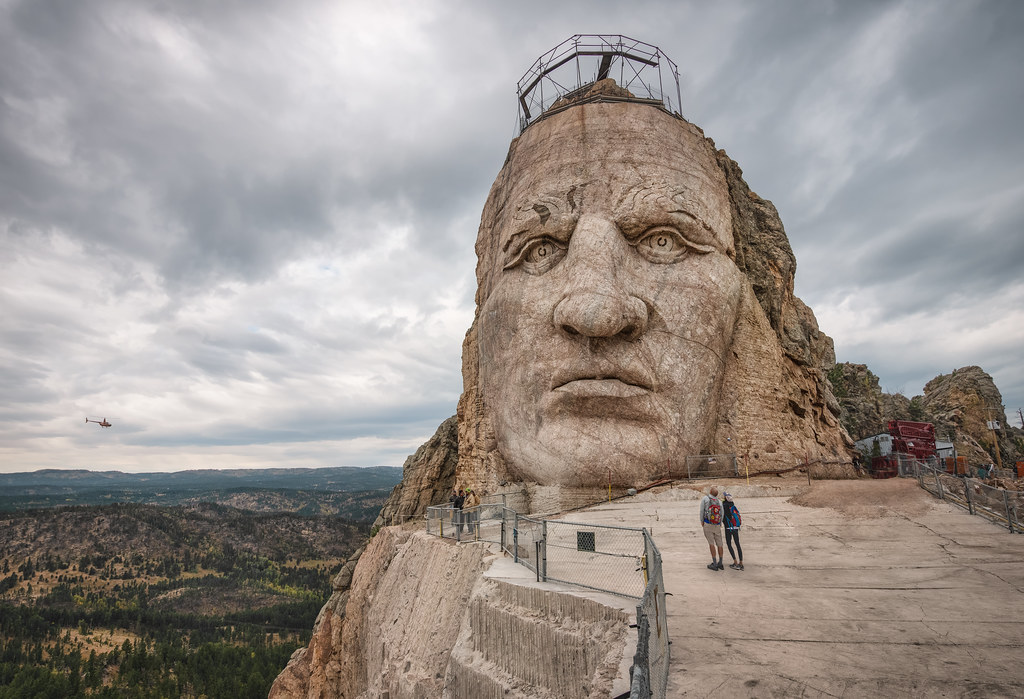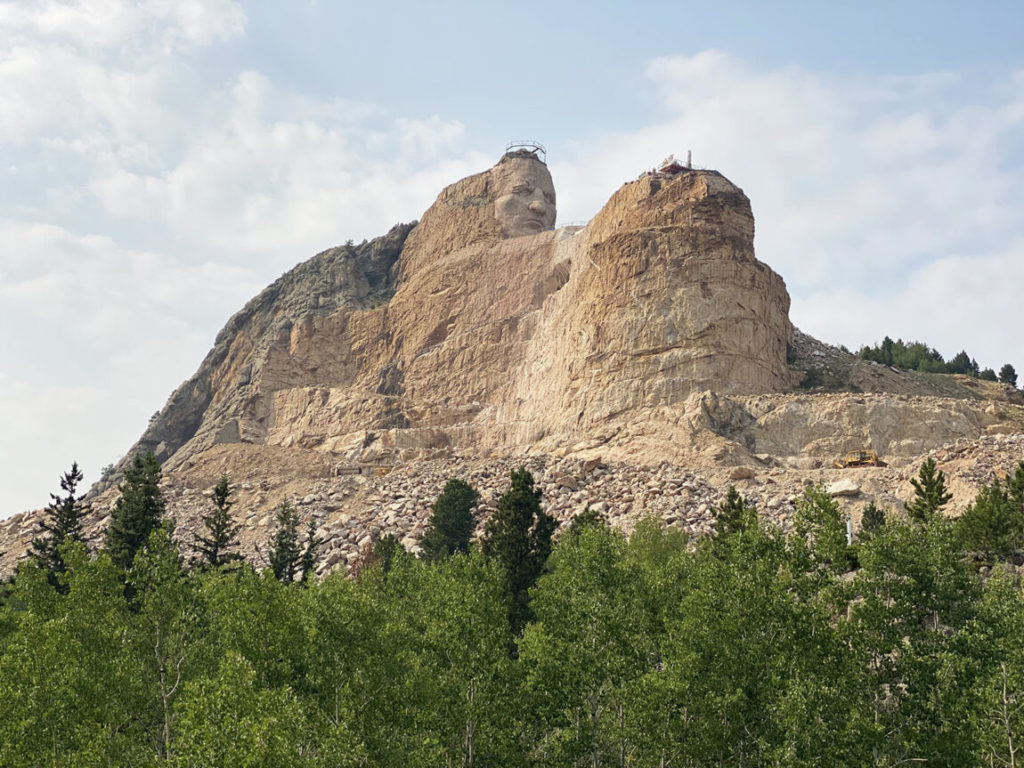Table of contents
In the sprawling expanse of the Black Hills of South Dakota, an iconic testament to Native American history and culture stands tall – the Crazy Horse Memorial. This majestic creation, often referred to as the Crazy Horse Monument or Cheif Crazy Horse Monument, is a captivating work of art that pays homage to a legendary Native American leader. Envisioned as a tribute to the Lakota Sioux warrior Crazy Horse, this monument is not only a towering sculpture but also a symbol of resilience, heritage, and the unbreakable spirit of a people. As we delve into the depths of the Crazy Horse Memorial, we’ll explore its significance, the history it embodies, its place within the rich Native American tapestry of South Dakota, the reasons behind its incomplete state, and even discover a perfect lodging option nearby.
Who Was Crazy Horse?
Before we can fully appreciate the magnitude of the Crazy Horse Memorial, it’s imperative to understand the man behind the monument – Crazy Horse himself. Born as Tȟašúŋke Witkó around 1840, Crazy Horse was a Lakota Sioux warrior and a prominent figure in the resistance against the encroachment of European settlers onto Native American lands. His legacy is intertwined with bravery, leadership, and a steadfast commitment to preserving his people’s way of life. His actions in battles like the Battle of Little Bighorn earned him a place of reverence among his people. By immortalizing Crazy Horse in a monumental sculpture, the creators of the memorial aim to honor his contributions to his tribe’s history and his relentless pursuit of freedom.
History of the Monument

The grandeur of the Crazy Horse Memorial is matched only by the magnitude of its purpose. The monument was initiated by Lakota Chief Henry Standing Bear, who, in 1939, wrote a letter to a sculptor named Korczak Ziolkowski. He implored Ziolkowski to carve a monument that would be a counterpoint to the faces of Mount Rushmore – a tribute to a Native American hero. The ambitious project began in 1948, and since then, it has evolved into a monumental work in progress. The primary focus of the sculpture is Crazy Horse mounted on his steed, pointing towards his ancestral lands. The dimensions of the monument are staggering; once completed, it will stand as the largest mountain carving in the world, a testament to the enduring legacy of Crazy Horse and his people.
Native American History in South Dakota
The story of the Crazy Horse Memorial is woven into the fabric of Native American history in South Dakota. The Black Hills, where the monument is located, are considered sacred by several Native American tribes, including the Lakota Sioux. These hills are not merely geographical landmarks; they hold deep spiritual significance. The memorial, situated in the heart of these hills, becomes a symbol of reclamation and resurgence. The history of the Native American tribes in South Dakota is one of struggle, survival, and cultural preservation in the face of adversity. The Crazy Horse Memorial, with its monumental presence, serves as a reminder of the enduring spirit of these communities.
Why Hasn’t It Been Completed?

The completion of the Crazy Horse Memorial has been a subject of both curiosity and controversy. While the monument’s progress has been steady, it’s important to approach this topic without bias. The reasons behind the extended timeline are multifaceted. The scale of the project itself is enormous – from the intricate details of Crazy Horse’s likeness to the challenges of carving into a mountainside. Funding, too, plays a role. The project is largely supported by private donations and visitor contributions, which can lead to fluctuations in the pace of work. Additionally, the monument’s mission is to honor not only Crazy Horse but all Native Americans. This makes the decision-making process complex, as the sculptors and custodians strive to balance artistic integrity with cultural sensitivity.
What Caused Crazy Horse’s Death?
Crazy Horse met his demise on September 5, 1877, at Camp Robinson in present-day Nebraska. While the circumstances of his death have been a subject of historical debate, it is widely believed that it resulted from a tragic altercation between the warrior and U.S. soldiers. The exact details, however, remain elusive.
According to some accounts, Crazy Horse had surrendered to U.S. authorities at the time, hoping to secure a better future for his people. It’s said that during his surrender, a scuffle ensued between him and a soldier, during which a bayonet pierced his kidney. This injury proved fatal, leading to his untimely death at the age of approximately 36.
Other accounts suggest a different version of events, contending that Crazy Horse’s death was an assassination, a deliberate act to eliminate a symbol of Native American resistance. Regardless of the circumstances, his death marked the end of an era and the decline of the Lakota Sioux’s struggle to preserve their way of life.
Crazy Horse’s legacy lives on not only in the monumental sculpture of the Crazy Horse Memorial but also in the enduring spirit of Native American communities. His death, while shrouded in mystery, serves as a poignant reminder of the challenges and sacrifices faced by Native American leaders during a tumultuous period in American history.
Conclusion
The Cheif Crazy Horse Monument stands as a testament to the indomitable spirit of the Lakota Sioux people and Native Americans as a whole. It encapsulates the essence of a warrior who fought valiantly to protect his people’s heritage and traditions. As we gaze upon the visage of Crazy Horse taking form on the mountainside, we’re reminded of the resilience that characterizes the human spirit. This monument is more than just a sculpture; it’s a living embodiment of history, culture, and the enduring pursuit of preserving the legacy of those who came before us. So, if you find yourself in the majestic lands of South Dakota, don’t miss the opportunity to witness the magnificence of the Crazy Horse Memorial – a tribute carved in stone to an unwavering legacy.
Need a Place to Stay Near Crazy Horse Memorial?
For those embarking on a journey to witness the awe-inspiring Cheif Crazy Horse Monument and the treasures of the surrounding area, finding suitable lodging is paramount. Look no further than the Black Hawk Creek RV Park. Open year-round, this park offers a haven for RV enthusiasts of all kinds. But what sets it apart is its unique accommodation option – it warmly welcomes horse travelers. Imagine staying in proximity to the memorial and sharing the experience with your equine companions. The park’s location is strategic, providing easy access to various attractions, including the iconic Mount Rushmore, the expansive Custer State Park, the otherworldly Badlands National Park, the legendary Devil’s Tower, and even the historic Wild West gambling town of Deadwood.

